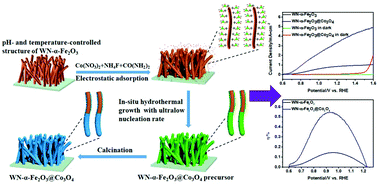Our official English website, www.x-mol.net, welcomes your feedback! (Note: you will need to create a separate account there.)
In situ growth of α-Fe2O3@Co3O4 core–shell wormlike nanoarrays for a highly efficient photoelectrochemical water oxidation reaction†
Nanoscale ( IF 5.8 ) Pub Date : 2018-12-12 00:00:00 , DOI: 10.1039/c8nr07041e Chunmei Li 1, 2, 3, 4, 5 , Zhihui Chen 6, 7, 8, 9 , Weiyong Yuan 1, 2, 3, 4, 5 , Qing-Hua Xu 6, 7, 8, 9 , Chang Ming Li 1, 2, 3, 4, 5
Nanoscale ( IF 5.8 ) Pub Date : 2018-12-12 00:00:00 , DOI: 10.1039/c8nr07041e Chunmei Li 1, 2, 3, 4, 5 , Zhihui Chen 6, 7, 8, 9 , Weiyong Yuan 1, 2, 3, 4, 5 , Qing-Hua Xu 6, 7, 8, 9 , Chang Ming Li 1, 2, 3, 4, 5
Affiliation

|
Photoelectrochemical (PEC) water splitting represents a promising strategy to convert solar energy into chemical energy in the form of hydrogen, but its performance is severely limited by the sluggish water oxidation reaction. Herein, for the first time, we report the direct assembly of an ultrathin, uniform, and dense layer of Co3O4 on wormlike nanostructured hematite (WN-α-Fe2O3) to form a large-area and high-density WN-α-Fe2O3@Co3O4 core–shell nanoarray via in situ hydrothermal growth followed by calcination, in which the electrostatic force between WN-α-Fe2O3 and the reactants, pH- and temperature-controlled structures of WN-α-Fe2O3, and ultralow nucleation rate of Co3O4 precursors all play critical roles. The obtained heteronanostructure array shows a photocurrent density of 3.48 mA cm−2, which is 4.05 times higher than that of pristine WN-α-Fe2O3 (0.86 mA cm−2), an onset potential of ∼0.62 V, 60 mV lower than that of α-Fe2O3 (∼0.68 V), and a photoconversion efficiency of 0.55%, 3.93 times higher than that of WN-α-Fe2O3 (0.14%). This is among the highest performances reported for Fe2O3-based photoanodes for water splitting. It is discovered that the Co3O4 shells can significantly enhance the charge separation, accelerate the charge transport and transfer, and reduce the charge transfer resistance from the photoelectrode to the electrolyte for a fast water oxidation reaction, thereby greatly promoting the PEC water oxidation performance of pristine WN-α-Fe2O3. This work not only creates a novel low-cost and Earth-abundant WN-α-Fe2O3@Co3O4 photoelectrode with superior PEC water oxidation performance and provides scientific insights into the enhancement mechanism, but also offers a general strategy for the in situ growth of water oxidation catalysts on various photoelectrodes with 3-D complex geometries for PEC water splitting.
中文翻译:

原位的α-Fe的生长2 ö 3 @Co 3 ö 4为一种高效的光电化学水的氧化反应的核-壳纳米阵列蠕虫状†
光电化学(PEC)分解水是一种有前途的策略,可以将太阳能以氢的形式转化为化学能,但其性能受到水氧化反应迟钝的严重限制。在此,在第一次,我们报告的超薄的,均匀的直接装配,和Co的致密层3 ö 4上的蠕虫状纳米结构赤铁矿(WN-的α-Fe 2 ö 3),以形成大面积和高密度WN-的α-Fe 2 ö 3 @Co 3 ö 4芯-壳纳米阵列通过原位水热生长接着进行煅烧,其中之间的静电力WN-的α-Fe 2 ö 3和反应物,pH-和WN-的α-Fe的温度控制的结构2 ö 3和Co的超低成核速率3 ö 4前体的所有中发挥关键作用。将所得到的heteronanostructure阵列节目3.48毫安厘米的光电流密度-2,它比原始的高4.05倍WN-的α-Fe 2 ö 3(0.86毫安厘米-2),~0.62 V的开始电位,60毫伏比的α-Fe的降低2 ö 3(~0.68 V),和0.55%时,光转换效率比的WN-的α-Fe更高3.93倍2 ö 3(0.14%)。这是铁的最高表现之一用于水分解的基于2 O 3的光阳极。发现Co 3 O 4壳层可以显着增强电荷分离,加速电荷的传输和转移,并降低从光电极到电解质的电荷转移阻力,从而实现快速的水氧化反应,从而极大地促进了PEC水的氧化原始WN-的α-Fe的性能2 ö 3。这项工作不仅创建了一个新的低成本和地球丰富WN-的α-Fe 2 ö 3 @Co 3 ö 4具有优异PEC水氧化性能的光电极,提供了增强机理的科学见解,但也为水氧化催化剂在具有3-D复杂几何形状的各种PEC水分解的光电极上原位生长提供了一般策略。
更新日期:2018-12-12
中文翻译:

原位的α-Fe的生长2 ö 3 @Co 3 ö 4为一种高效的光电化学水的氧化反应的核-壳纳米阵列蠕虫状†
光电化学(PEC)分解水是一种有前途的策略,可以将太阳能以氢的形式转化为化学能,但其性能受到水氧化反应迟钝的严重限制。在此,在第一次,我们报告的超薄的,均匀的直接装配,和Co的致密层3 ö 4上的蠕虫状纳米结构赤铁矿(WN-的α-Fe 2 ö 3),以形成大面积和高密度WN-的α-Fe 2 ö 3 @Co 3 ö 4芯-壳纳米阵列通过原位水热生长接着进行煅烧,其中之间的静电力WN-的α-Fe 2 ö 3和反应物,pH-和WN-的α-Fe的温度控制的结构2 ö 3和Co的超低成核速率3 ö 4前体的所有中发挥关键作用。将所得到的heteronanostructure阵列节目3.48毫安厘米的光电流密度-2,它比原始的高4.05倍WN-的α-Fe 2 ö 3(0.86毫安厘米-2),~0.62 V的开始电位,60毫伏比的α-Fe的降低2 ö 3(~0.68 V),和0.55%时,光转换效率比的WN-的α-Fe更高3.93倍2 ö 3(0.14%)。这是铁的最高表现之一用于水分解的基于2 O 3的光阳极。发现Co 3 O 4壳层可以显着增强电荷分离,加速电荷的传输和转移,并降低从光电极到电解质的电荷转移阻力,从而实现快速的水氧化反应,从而极大地促进了PEC水的氧化原始WN-的α-Fe的性能2 ö 3。这项工作不仅创建了一个新的低成本和地球丰富WN-的α-Fe 2 ö 3 @Co 3 ö 4具有优异PEC水氧化性能的光电极,提供了增强机理的科学见解,但也为水氧化催化剂在具有3-D复杂几何形状的各种PEC水分解的光电极上原位生长提供了一般策略。











































 京公网安备 11010802027423号
京公网安备 11010802027423号